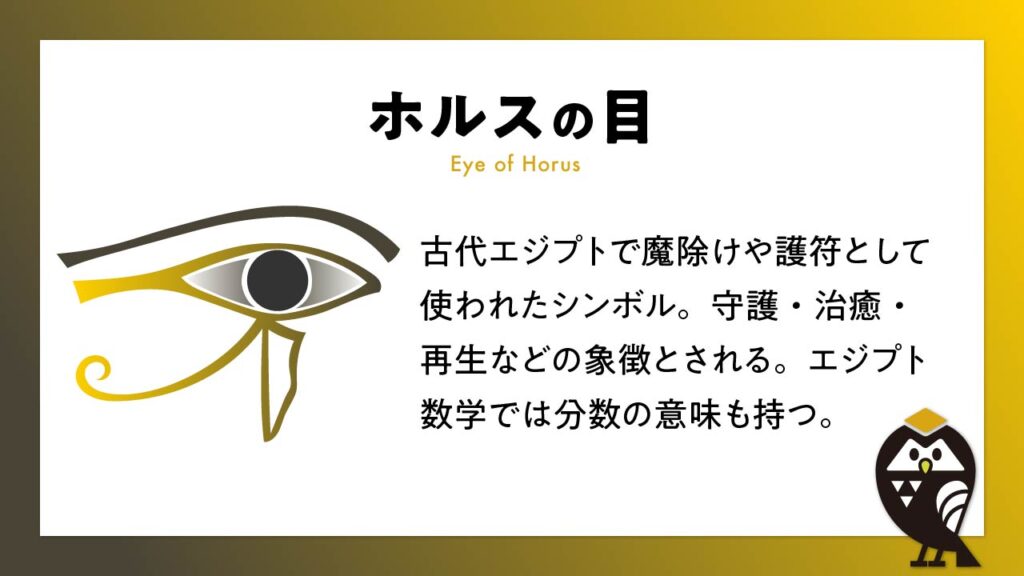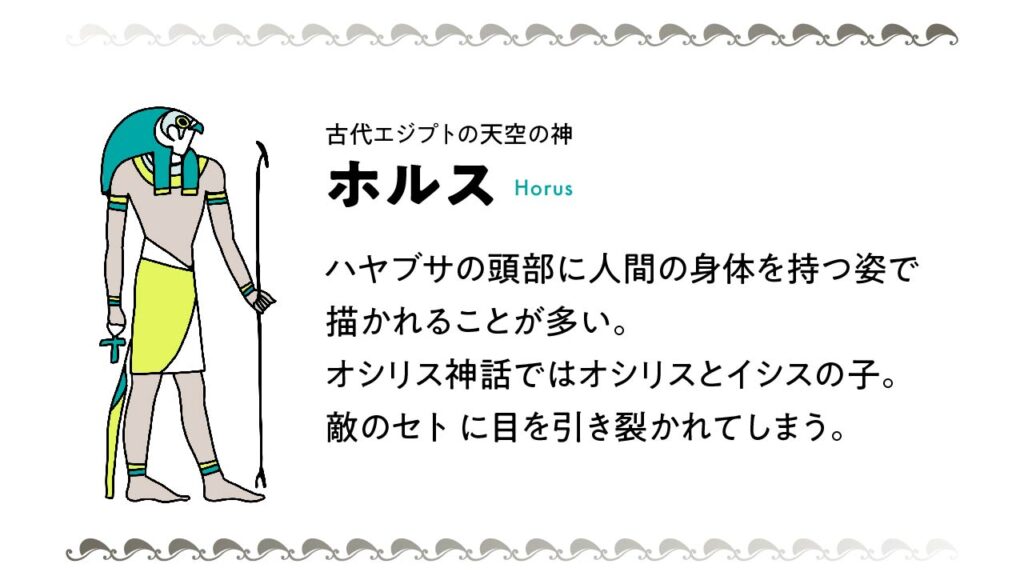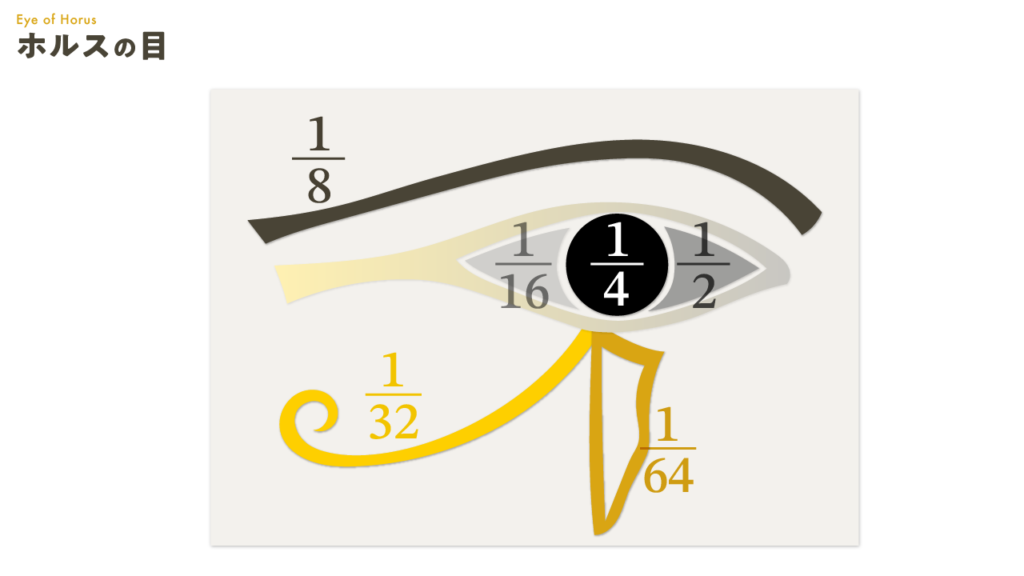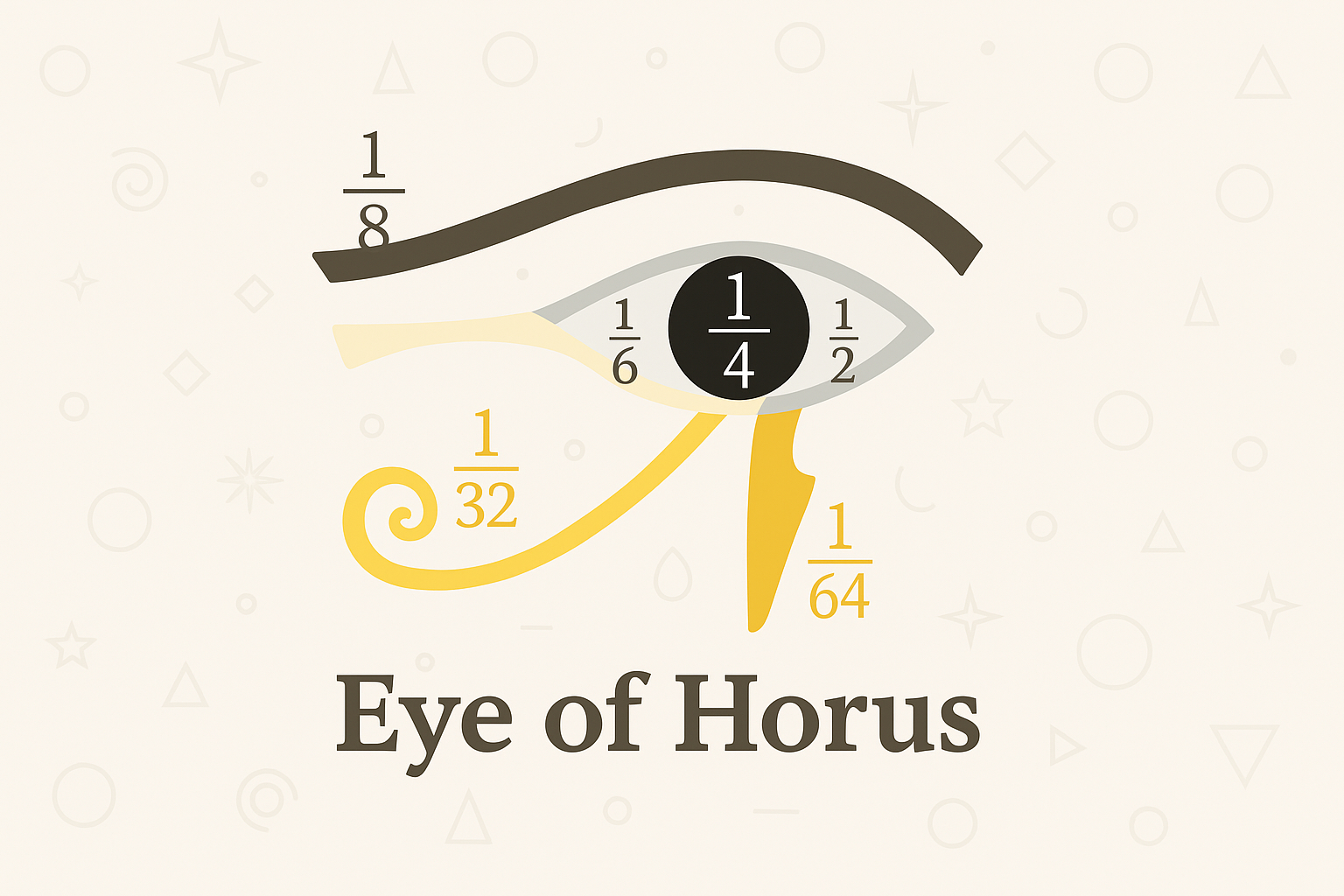he Eye of Horus is a mystical symbol often found in ancient Egyptian wall paintings and decorations. It was believed to embody protective, healing, and regenerative powers, and has long been used as an amulet or talisman to ward off evil.
In addition, the symbol was also used in ancient Egyptian mathematics to represent fractional values, giving it a unique role that combines both mysticism and practical utility.

Mythological Background of the Eye of Horus
Who Is Horus, the Sky God of Ancient Egypt?
Horus is the sky god in ancient Egyptian mythology and is typically depicted as a falcon or a man with a falcon’s head.
He is the son of Osiris and Isis, and one of the most important deities in Egyptian mythology.
According to myth, Horus’s father Osiris was murdered by his brother Set. After growing up, Horus fought Set to avenge his father and ultimately triumphed, becoming the rightful ruler who united Upper and Lower Egypt.

The Myth of Osiris and the Birth of the Eye of Horus
Osiris, the father of Horus, was a wise and beloved king who ruled over ancient Egypt. However, his brother Set grew envious of his power and plotted to kill Osiris in order to seize the throne.
In time, Horus grew up and challenged Set to avenge his father. During their fierce and prolonged battle, Set tore out one of Horus’s eyes. The injured eye was later healed and restored to its original form by Thoth, the god of wisdom and the moon.
From this myth, the “Eye of Horus” came to be widely revered in ancient Egypt as a powerful symbol of healing and restoration.
The Sun and the Moon: The Two Eyes of Horus
he Eye of Horus is said to consist of two parts—his right eye and left eye.
The right eye represents the sun,
while the left eye symbolizes the moon.
The left eye, in particular, is known as the Eye of Udjat (or Udjat Eye), and is associated with protection, healing, and restoration. It is the eye that was damaged in Horus’s battle with Set and later healed by the god Thoth.
This eye became a powerful amulet in ancient Egypt, used by both pharaohs and ordinary people as a protective charm against evil. It appeared frequently in jewelry, artwork, and religious items as a symbol of divine safeguarding.
The Eye of Horus and Egyptian Fractions
How to Express Numbers Less Than One
In modern times, we use words like half and quarter to express numbers less than one—fractions. These terms are common across many languages today.
But how were such numbers expressed in ancient Egypt?
In Egyptian mathematics, there were specific fractions such as 1/2, 1/4, 1/8, 1/16, 1/32, and 1/64. These successively halved fractions held special meaning and were each represented by distinct symbols.
Interestingly, the Japanese language also uses expressions like “happu” (八分) and “jūroppun” (十六分), meaning “one-eighth” and “one-sixteenth.” While Japanese expresses fractions as “number + 分 (bun),” in ancient Egypt, each of these fractional values was treated as an independent unit with its own unique symbol.
The Connection Between the Eye of Horus and Fractions
Surprisingly, these fractional values are believed to correspond to parts of the Eye of Horus.
For example:
- The pupil represents 1/4
- The eyebrow represents 1/8
- The teardrop-like marking symbolizes 1/32
In this way, each component of the Eye of Horus was associated with a specific unit fraction.
Thus, the Eye of Horus was not merely a mythological symbol—it was also deeply connected to mathematical knowledge and the ancient Egyptian worldview of numbers.

The Fractions Represented by the Parts of the Eye of Horus
Each part of the Eye of Horus is said to represent one of the following unit fractions:
1/2, 1/4, 1/8, 1/16, 1/32, and 1/64.
When all of these fractions are added together, the total is 63/64. In other words, it falls just short of a whole—an “incomplete number.”
This missing 1/64 is believed to symbolize the left eye of Horus that was damaged during his battle with Set.
At the same time, according to the myth, the god Thoth healed Horus’s wounded eye. As a result, the Eye of Horus also came to symbolize the process of restoration, healing, and the pursuit of wholeness.
Summary: The Eye of Horus — Symbol of Protection, Mathematics, and Myth
The Eye of Horus is one of the most iconic and multifaceted symbols of ancient Egypt. Known as a powerful emblem of protection, healing, and rebirth, it appears frequently in amulets, temple art, and royal regalia.
Mythologically, it represents the left eye of the sky god Horus, which was damaged during his battle with Set and later restored by the god Thoth. This story made the eye a symbol not only of injury, but of restoration and completeness.
Mathematically, each part of the Eye of Horus corresponds to a unit fraction—1/2, 1/4, 1/8, 1/16, 1/32, and 1/64—adding up to 63/64. This “incomplete total” reflects the wounded eye, while the act of healing gives it symbolic wholeness.
Thus, the Eye of Horus unites myth and mathematics, serving as a profound representation of both ancient Egyptian spirituality and their advanced understanding of numbers.

